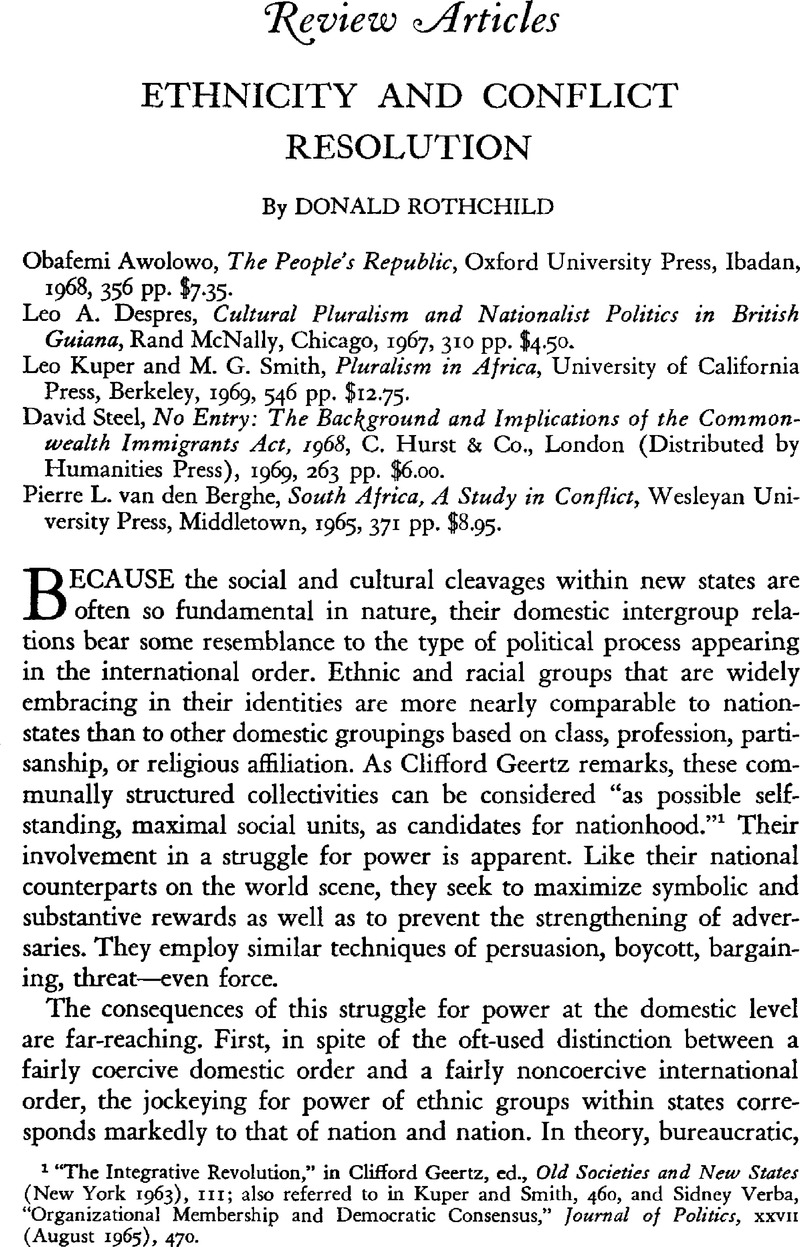Published online by Cambridge University Press: 18 July 2011

1 “The Integrative Revolution,” in Geertz, Clifford, ed., Old Societies and Netv States (New York 1963)Google Scholar, III; also referred to in Kuper and Smith, 460, and Verba, Sidney, “Organizational Membership and Democratic Consensus,” Journal of Politics, XXVII (August 1965), 470Google Scholar.
2 Emerson, Rupert, “The Problem of Identity, Selfhood, and Image in the New Nations: The Situation in Africa,” Comparative Politics, 1 (April 1969), 306CrossRefGoogle Scholar.
3 Furnivall, J. S., Netherlands India (Cambridge 1939), 446Google Scholar.
4 Carter, Gwendolen M., Karis, Thomas, and Stultz, Newell M., South Africa's Transkei: The Politics of Domestic Colonialism (Evanston 1967)Google Scholar. See also Carmichael, Stokely and Hamilton, Charles V., Black Power: The Politics of Liberation in America (New York 1967), 5–6Google Scholar.
5 Dotson, Floyd and Dotson, Lillian O., The Indian Minority of Zambia, Rhodesia, and Malawi (New Haven 1968), 394Google Scholar.
6 As Ralf Dahrendorf shows with regard to class structure, increased mobility within the groups has the effect of diminishing the intensity of intergroup conflict. Class and Class Conflict in Industrial Society (Stanford 1959), 60.
7 “Cultural Assimilation in a Multiracial Society,” Annals of the New York Academy of Sciences, LXXXIII (January 1960), 852.
8 The Indians in Uganda (Chicago 1968), 168–69Google Scholar. See also Kuper and Smith, 385-87, and Benedict, Burton, Indians in a Plural Society: A Report on Mauritius, Colonial Research Studies, XXXIV (London 1961), 32, 45Google Scholar.
9 An African Bourgeoisie: Race, Class, and Politics in South Africa (New Haven 1965), 5–6Google Scholar.
10 For a discussion of the variations in the closeness of intercommunity connections, see Rothchild, Donald, “Ethnic Inequalities in Kenya,” Journal of Modern African Studies, VII (December 1969), 689–711CrossRefGoogle Scholar.
11 At the first session of the Aburi conference, the parties agreed to a resolution presented by Lt. Col. Odumegwu Ojukwu, the Military Governor of Eastern Nigeria, reaffirming their “faith in discussions and negotiations as the only peaceable way of resolving the Nigerian crisis,” The Verbatim Report of the Proceedings of the Supreme Military Council Meeting, Aburi, Accra, Ghana, January 4-5, 1967 (Enugu 1967), 13-14. See also Schwarz, Walter, Nigeria (New York 1968), 225Google Scholar.
12 “Violent Contiguity and the Politics of the Retribalization in Africa,” Journal of International Affairs, XXIII (No. I, 1969), 89. Italics as in text. According to an editorial in the Target of Kenya, Mboya's death brought to public attention what many knew in their hearts—”that all, with perhaps very few exceptions, still ardently regard their own tribes as little nations within the nation, and their national loyalty only comes second to their tribal loyalty.” East African Standard (Nairobi), July 28, 1969, 5.
13 Uganda Argus (Kampala), May 19, 1969, 1. A more extensive discussion of Obote's negotiations with local nationalist interests appears in Donald Rothchild and Michael Rogin, “Uganda” in Carter, Gwendolen, ed., National Unity and Regionalism in Eight African States (Ithaca 1966), 344–51, 359-60, 370-79Google Scholar.
14 East African Standard (Nairobi), July 25, 1969, 1, 6.
15 Ibid., January 1, 1969, 1, 6.
16 See my “From Federalism to Neo-Federalism,” in Rothchild, Donald, ed., Politics of Integration: An East African Documentary (Nairobi 1968), 9–12Google Scholar.
17 “Color, the Universal Intellectual Community, and the Afro-Asian Intellectual,” in Daedalus, XCVI (Spring 1967), 282.
18 East African Standard (Nairobi), July 30, 1969, 9. When a point is reached in this and analogous cases where both sides to a violent encounter perceive the costs of continued warfare to be excessive, reciprocity between collectives may again become a meaningful possibility.
19 The Autobiography of Malcolm X (New York 1964), 276.
20 For the distinction between “assimilable” and “unassimilable” minorities, see Kuper and Smith, 250, and Groth, Alexander J., “The Legacy of Three Crises: Parliament and Ethnic Issues in Prewar Poland,” Slavic Review, XXVII (December 1968), 578Google Scholar.
21 A fuller treatment of this subject appears in Rothchild, Donald, “Kenya's Minorities and the African Crisis over Citizenship,” Race, IX (April 1968), 421–37CrossRefGoogle Scholar.
22 The Division of Labor in Society (New York 1966), 276.
23 Some appeals for the adoption of proportional representation appear in Enid Lake-man and Lambert, James D., Voting in Democracies (London 1959), 148Google Scholar, 172; Lewis, W. Arthur, Politics in West Africa (London 1965), 72–74Google Scholar; Kenya Calling, August 8, 1959) 75 and West Africa, March 27, 1965, 334, and October 23, 1965, 1177.
24 Lewis, 70. See also Lijphart, Arend, “Consociational Democracy,” World Politics, xxi (January 1969), 212Google Scholar.
25 Coleman, James S., Community Conflict (New York 1957), 14Google Scholar.